Function of Deliberate Self-Harm in Child and Adolescent Mental Health Services
VerifiedAdded on 2023/01/19
|17
|6375
|34
AI Summary
Deliberate self-harm is a prominent mental health concern among children and adolescents. This study explores the self-harm practices, reasons behind self-harm, its impact on mental health, and strategies to reduce self-harm. Qualitative research is used to analyze secondary data. It is important to provide support and treatment to children and adolescents with self-harm tendencies.
Contribute Materials
Your contribution can guide someone’s learning journey. Share your
documents today.

What is the function of deliberate
self-harm within child and
adolescent mental health services
self-harm within child and
adolescent mental health services
Secure Best Marks with AI Grader
Need help grading? Try our AI Grader for instant feedback on your assignments.

ABSTRACT
Deliberate self-harming is a prominent mental health concern within the young and
adolescent people. It is complicated situation where someone harms and injures themselves due
to mental pressure and depression. They can harm themselves by cutting, burning, hitting and
pulling themselves hair so badly that it can more hurt them. In the above study it is find some
self-harm practices which can adopted by individual for harming themselves. Afterwards
admitting the reasons of self-harm within the children and adolescent. Self harming practices
which are affecting the mental health of the adolescent. And various strategies for reducing the
self harm within adolescent and children with mental illness. Qualitative method is used for the
secondary research data for researching the data for this study. It is very important for family to
teachers to morally support the child so that they can help their child to achieve life objective and
live life with positive attitude and feel motivated.
Deliberate self-harming is a prominent mental health concern within the young and
adolescent people. It is complicated situation where someone harms and injures themselves due
to mental pressure and depression. They can harm themselves by cutting, burning, hitting and
pulling themselves hair so badly that it can more hurt them. In the above study it is find some
self-harm practices which can adopted by individual for harming themselves. Afterwards
admitting the reasons of self-harm within the children and adolescent. Self harming practices
which are affecting the mental health of the adolescent. And various strategies for reducing the
self harm within adolescent and children with mental illness. Qualitative method is used for the
secondary research data for researching the data for this study. It is very important for family to
teachers to morally support the child so that they can help their child to achieve life objective and
live life with positive attitude and feel motivated.
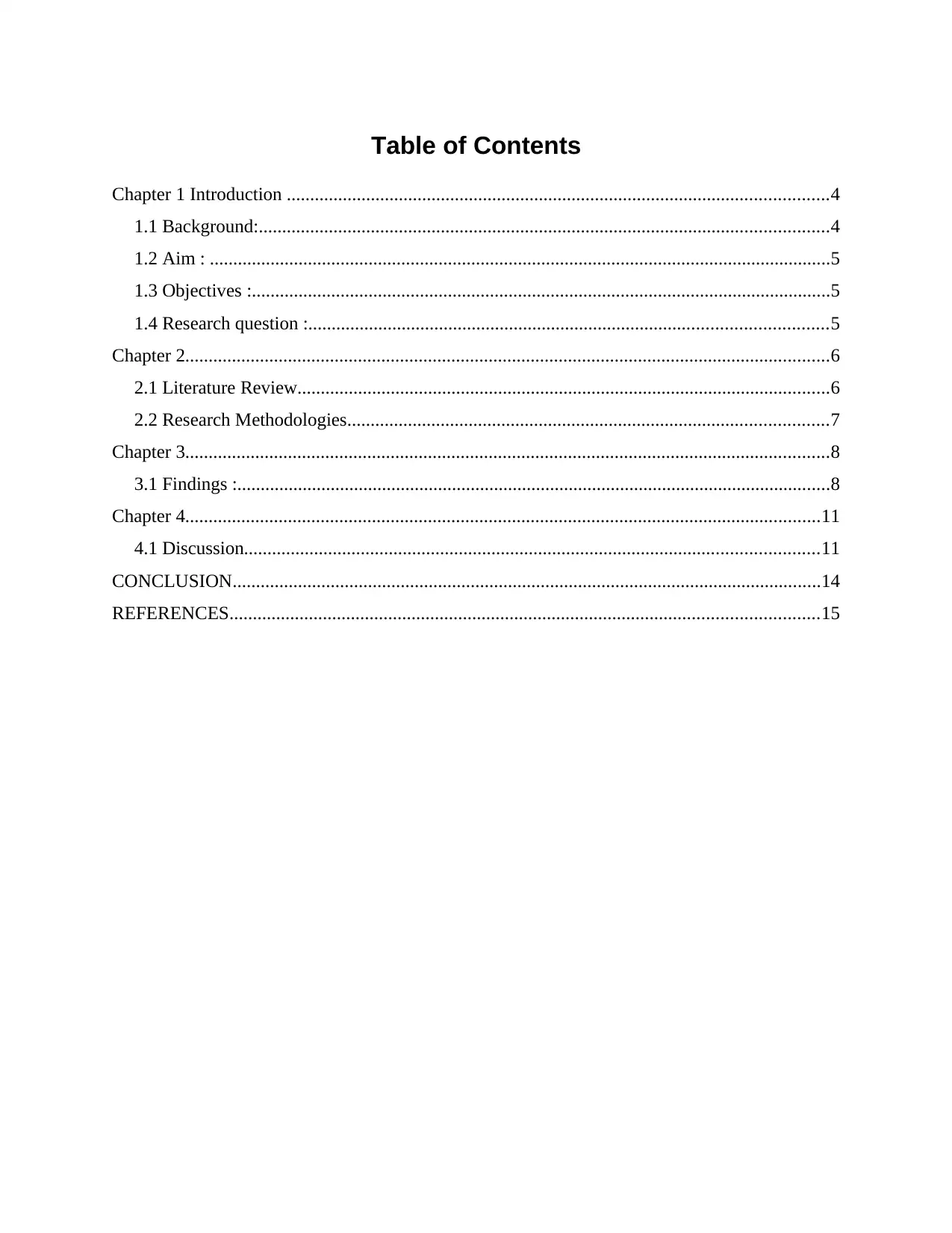
Table of Contents
Chapter 1 Introduction ....................................................................................................................4
1.1 Background:..........................................................................................................................4
1.2 Aim : .....................................................................................................................................5
1.3 Objectives :............................................................................................................................5
1.4 Research question :...............................................................................................................5
Chapter 2..........................................................................................................................................6
2.1 Literature Review..................................................................................................................6
2.2 Research Methodologies.......................................................................................................7
Chapter 3..........................................................................................................................................8
3.1 Findings :...............................................................................................................................8
Chapter 4........................................................................................................................................11
4.1 Discussion...........................................................................................................................11
CONCLUSION..............................................................................................................................14
REFERENCES..............................................................................................................................15
Chapter 1 Introduction ....................................................................................................................4
1.1 Background:..........................................................................................................................4
1.2 Aim : .....................................................................................................................................5
1.3 Objectives :............................................................................................................................5
1.4 Research question :...............................................................................................................5
Chapter 2..........................................................................................................................................6
2.1 Literature Review..................................................................................................................6
2.2 Research Methodologies.......................................................................................................7
Chapter 3..........................................................................................................................................8
3.1 Findings :...............................................................................................................................8
Chapter 4........................................................................................................................................11
4.1 Discussion...........................................................................................................................11
CONCLUSION..............................................................................................................................14
REFERENCES..............................................................................................................................15
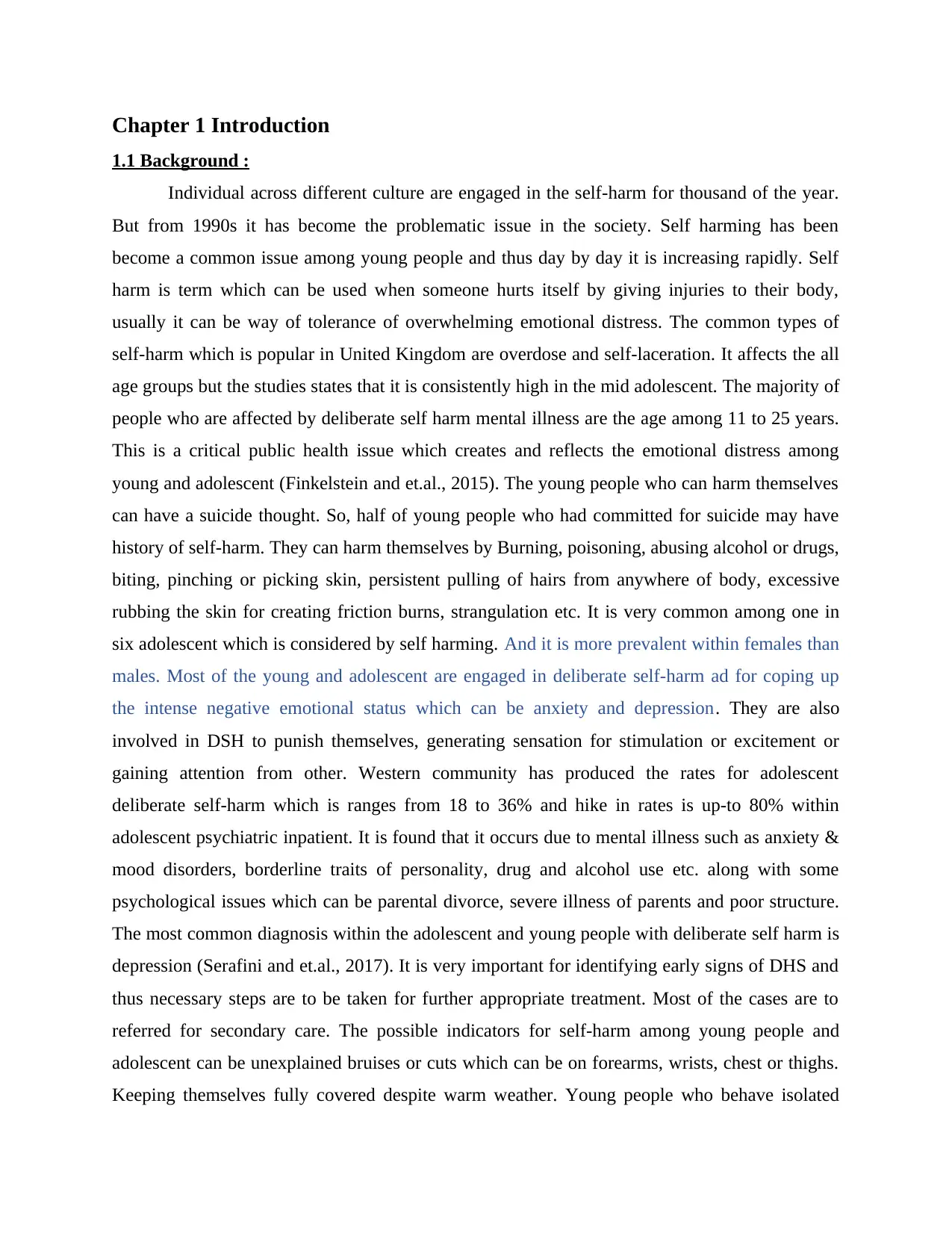
Chapter 1 Introduction
1.1 Background :
Individual across different culture are engaged in the self-harm for thousand of the year.
But from 1990s it has become the problematic issue in the society. Self harming has been
become a common issue among young people and thus day by day it is increasing rapidly. Self
harm is term which can be used when someone hurts itself by giving injuries to their body,
usually it can be way of tolerance of overwhelming emotional distress. The common types of
self-harm which is popular in United Kingdom are overdose and self-laceration. It affects the all
age groups but the studies states that it is consistently high in the mid adolescent. The majority of
people who are affected by deliberate self harm mental illness are the age among 11 to 25 years.
This is a critical public health issue which creates and reflects the emotional distress among
young and adolescent (Finkelstein and et.al., 2015). The young people who can harm themselves
can have a suicide thought. So, half of young people who had committed for suicide may have
history of self-harm. They can harm themselves by Burning, poisoning, abusing alcohol or drugs,
biting, pinching or picking skin, persistent pulling of hairs from anywhere of body, excessive
rubbing the skin for creating friction burns, strangulation etc. It is very common among one in
six adolescent which is considered by self harming. And it is more prevalent within females than
males. Most of the young and adolescent are engaged in deliberate self-harm ad for coping up
the intense negative emotional status which can be anxiety and depression. They are also
involved in DSH to punish themselves, generating sensation for stimulation or excitement or
gaining attention from other. Western community has produced the rates for adolescent
deliberate self-harm which is ranges from 18 to 36% and hike in rates is up-to 80% within
adolescent psychiatric inpatient. It is found that it occurs due to mental illness such as anxiety &
mood disorders, borderline traits of personality, drug and alcohol use etc. along with some
psychological issues which can be parental divorce, severe illness of parents and poor structure.
The most common diagnosis within the adolescent and young people with deliberate self harm is
depression (Serafini and et.al., 2017). It is very important for identifying early signs of DHS and
thus necessary steps are to be taken for further appropriate treatment. Most of the cases are to
referred for secondary care. The possible indicators for self-harm among young people and
adolescent can be unexplained bruises or cuts which can be on forearms, wrists, chest or thighs.
Keeping themselves fully covered despite warm weather. Young people who behave isolated
1.1 Background :
Individual across different culture are engaged in the self-harm for thousand of the year.
But from 1990s it has become the problematic issue in the society. Self harming has been
become a common issue among young people and thus day by day it is increasing rapidly. Self
harm is term which can be used when someone hurts itself by giving injuries to their body,
usually it can be way of tolerance of overwhelming emotional distress. The common types of
self-harm which is popular in United Kingdom are overdose and self-laceration. It affects the all
age groups but the studies states that it is consistently high in the mid adolescent. The majority of
people who are affected by deliberate self harm mental illness are the age among 11 to 25 years.
This is a critical public health issue which creates and reflects the emotional distress among
young and adolescent (Finkelstein and et.al., 2015). The young people who can harm themselves
can have a suicide thought. So, half of young people who had committed for suicide may have
history of self-harm. They can harm themselves by Burning, poisoning, abusing alcohol or drugs,
biting, pinching or picking skin, persistent pulling of hairs from anywhere of body, excessive
rubbing the skin for creating friction burns, strangulation etc. It is very common among one in
six adolescent which is considered by self harming. And it is more prevalent within females than
males. Most of the young and adolescent are engaged in deliberate self-harm ad for coping up
the intense negative emotional status which can be anxiety and depression. They are also
involved in DSH to punish themselves, generating sensation for stimulation or excitement or
gaining attention from other. Western community has produced the rates for adolescent
deliberate self-harm which is ranges from 18 to 36% and hike in rates is up-to 80% within
adolescent psychiatric inpatient. It is found that it occurs due to mental illness such as anxiety &
mood disorders, borderline traits of personality, drug and alcohol use etc. along with some
psychological issues which can be parental divorce, severe illness of parents and poor structure.
The most common diagnosis within the adolescent and young people with deliberate self harm is
depression (Serafini and et.al., 2017). It is very important for identifying early signs of DHS and
thus necessary steps are to be taken for further appropriate treatment. Most of the cases are to
referred for secondary care. The possible indicators for self-harm among young people and
adolescent can be unexplained bruises or cuts which can be on forearms, wrists, chest or thighs.
Keeping themselves fully covered despite warm weather. Young people who behave isolated
Secure Best Marks with AI Grader
Need help grading? Try our AI Grader for instant feedback on your assignments.
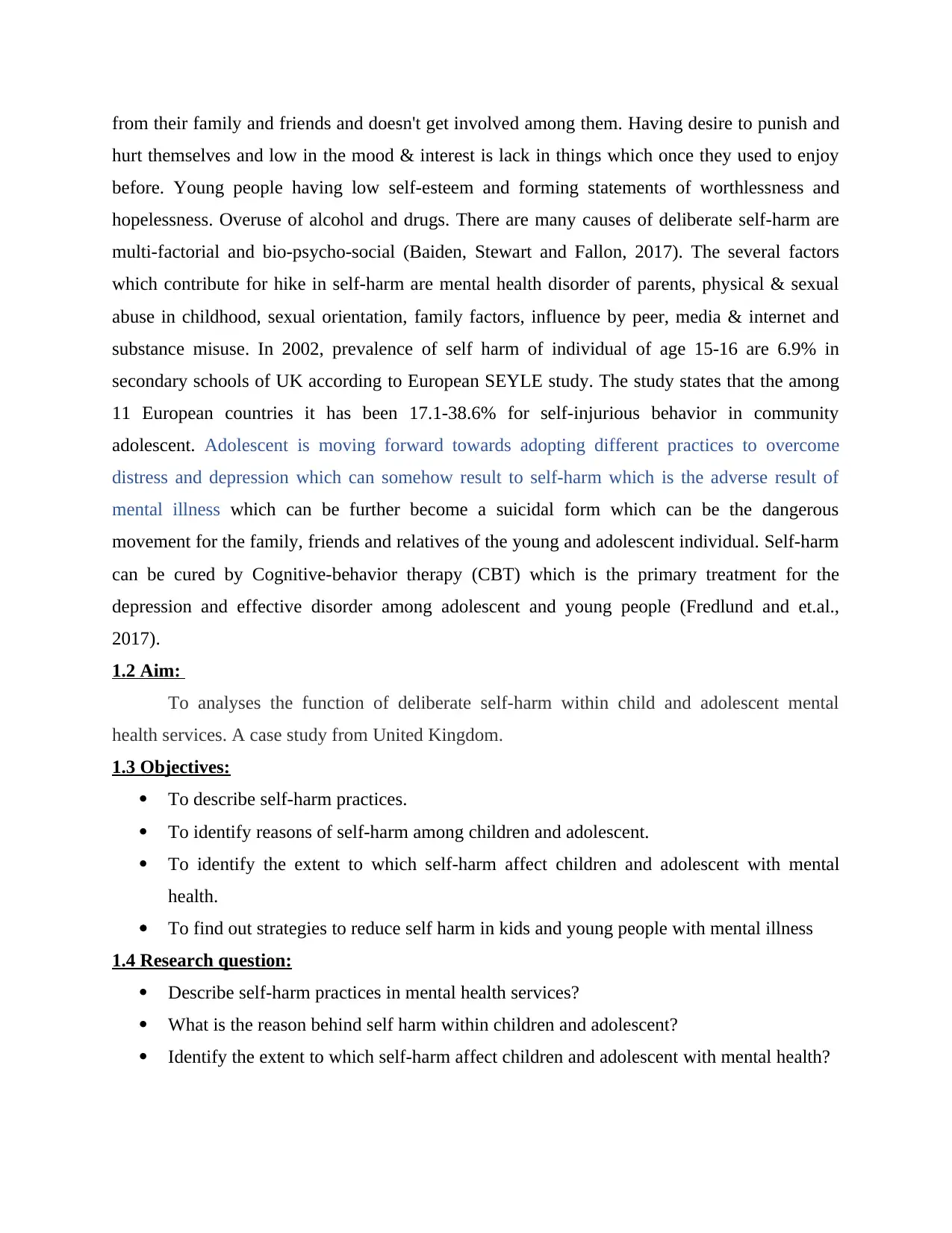
from their family and friends and doesn't get involved among them. Having desire to punish and
hurt themselves and low in the mood & interest is lack in things which once they used to enjoy
before. Young people having low self-esteem and forming statements of worthlessness and
hopelessness. Overuse of alcohol and drugs. There are many causes of deliberate self-harm are
multi-factorial and bio-psycho-social (Baiden, Stewart and Fallon, 2017). The several factors
which contribute for hike in self-harm are mental health disorder of parents, physical & sexual
abuse in childhood, sexual orientation, family factors, influence by peer, media & internet and
substance misuse. In 2002, prevalence of self harm of individual of age 15-16 are 6.9% in
secondary schools of UK according to European SEYLE study. The study states that the among
11 European countries it has been 17.1-38.6% for self-injurious behavior in community
adolescent. Adolescent is moving forward towards adopting different practices to overcome
distress and depression which can somehow result to self-harm which is the adverse result of
mental illness which can be further become a suicidal form which can be the dangerous
movement for the family, friends and relatives of the young and adolescent individual. Self-harm
can be cured by Cognitive-behavior therapy (CBT) which is the primary treatment for the
depression and effective disorder among adolescent and young people (Fredlund and et.al.,
2017).
1.2 Aim:
To analyses the function of deliberate self-harm within child and adolescent mental
health services. A case study from United Kingdom.
1.3 Objectives:
To describe self-harm practices.
To identify reasons of self-harm among children and adolescent.
To identify the extent to which self-harm affect children and adolescent with mental
health.
To find out strategies to reduce self harm in kids and young people with mental illness
1.4 Research question:
Describe self-harm practices in mental health services?
What is the reason behind self harm within children and adolescent?
Identify the extent to which self-harm affect children and adolescent with mental health?
hurt themselves and low in the mood & interest is lack in things which once they used to enjoy
before. Young people having low self-esteem and forming statements of worthlessness and
hopelessness. Overuse of alcohol and drugs. There are many causes of deliberate self-harm are
multi-factorial and bio-psycho-social (Baiden, Stewart and Fallon, 2017). The several factors
which contribute for hike in self-harm are mental health disorder of parents, physical & sexual
abuse in childhood, sexual orientation, family factors, influence by peer, media & internet and
substance misuse. In 2002, prevalence of self harm of individual of age 15-16 are 6.9% in
secondary schools of UK according to European SEYLE study. The study states that the among
11 European countries it has been 17.1-38.6% for self-injurious behavior in community
adolescent. Adolescent is moving forward towards adopting different practices to overcome
distress and depression which can somehow result to self-harm which is the adverse result of
mental illness which can be further become a suicidal form which can be the dangerous
movement for the family, friends and relatives of the young and adolescent individual. Self-harm
can be cured by Cognitive-behavior therapy (CBT) which is the primary treatment for the
depression and effective disorder among adolescent and young people (Fredlund and et.al.,
2017).
1.2 Aim:
To analyses the function of deliberate self-harm within child and adolescent mental
health services. A case study from United Kingdom.
1.3 Objectives:
To describe self-harm practices.
To identify reasons of self-harm among children and adolescent.
To identify the extent to which self-harm affect children and adolescent with mental
health.
To find out strategies to reduce self harm in kids and young people with mental illness
1.4 Research question:
Describe self-harm practices in mental health services?
What is the reason behind self harm within children and adolescent?
Identify the extent to which self-harm affect children and adolescent with mental health?
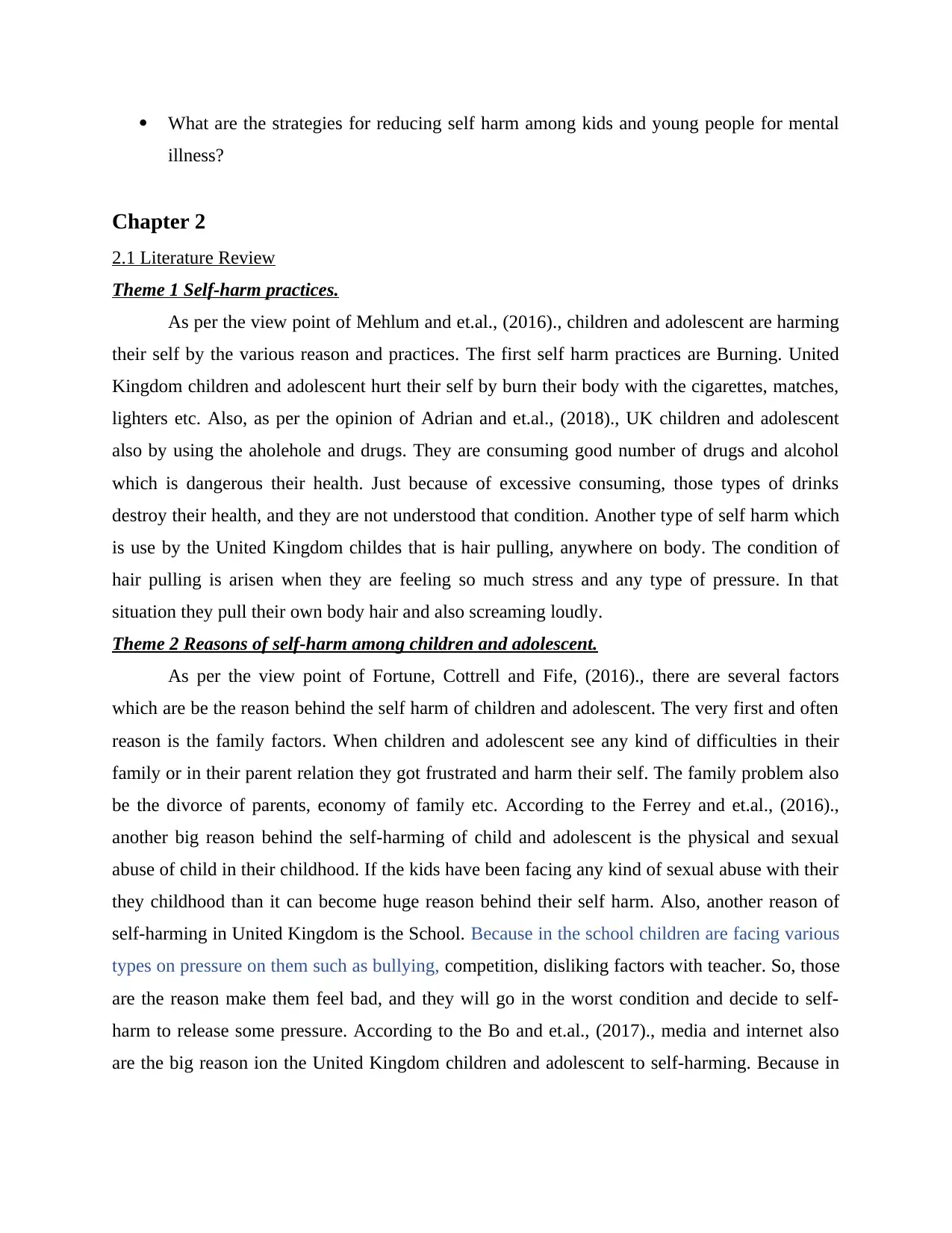
What are the strategies for reducing self harm among kids and young people for mental
illness?
Chapter 2
2.1 Literature Review
Theme 1 Self-harm practices.
As per the view point of Mehlum and et.al., (2016)., children and adolescent are harming
their self by the various reason and practices. The first self harm practices are Burning. United
Kingdom children and adolescent hurt their self by burn their body with the cigarettes, matches,
lighters etc. Also, as per the opinion of Adrian and et.al., (2018)., UK children and adolescent
also by using the aholehole and drugs. They are consuming good number of drugs and alcohol
which is dangerous their health. Just because of excessive consuming, those types of drinks
destroy their health, and they are not understood that condition. Another type of self harm which
is use by the United Kingdom childes that is hair pulling, anywhere on body. The condition of
hair pulling is arisen when they are feeling so much stress and any type of pressure. In that
situation they pull their own body hair and also screaming loudly.
Theme 2 Reasons of self-harm among children and adolescent.
As per the view point of Fortune, Cottrell and Fife, (2016)., there are several factors
which are be the reason behind the self harm of children and adolescent. The very first and often
reason is the family factors. When children and adolescent see any kind of difficulties in their
family or in their parent relation they got frustrated and harm their self. The family problem also
be the divorce of parents, economy of family etc. According to the Ferrey and et.al., (2016).,
another big reason behind the self-harming of child and adolescent is the physical and sexual
abuse of child in their childhood. If the kids have been facing any kind of sexual abuse with their
they childhood than it can become huge reason behind their self harm. Also, another reason of
self-harming in United Kingdom is the School. Because in the school children are facing various
types on pressure on them such as bullying, competition, disliking factors with teacher. So, those
are the reason make them feel bad, and they will go in the worst condition and decide to self-
harm to release some pressure. According to the Bo and et.al., (2017)., media and internet also
are the big reason ion the United Kingdom children and adolescent to self-harming. Because in
illness?
Chapter 2
2.1 Literature Review
Theme 1 Self-harm practices.
As per the view point of Mehlum and et.al., (2016)., children and adolescent are harming
their self by the various reason and practices. The first self harm practices are Burning. United
Kingdom children and adolescent hurt their self by burn their body with the cigarettes, matches,
lighters etc. Also, as per the opinion of Adrian and et.al., (2018)., UK children and adolescent
also by using the aholehole and drugs. They are consuming good number of drugs and alcohol
which is dangerous their health. Just because of excessive consuming, those types of drinks
destroy their health, and they are not understood that condition. Another type of self harm which
is use by the United Kingdom childes that is hair pulling, anywhere on body. The condition of
hair pulling is arisen when they are feeling so much stress and any type of pressure. In that
situation they pull their own body hair and also screaming loudly.
Theme 2 Reasons of self-harm among children and adolescent.
As per the view point of Fortune, Cottrell and Fife, (2016)., there are several factors
which are be the reason behind the self harm of children and adolescent. The very first and often
reason is the family factors. When children and adolescent see any kind of difficulties in their
family or in their parent relation they got frustrated and harm their self. The family problem also
be the divorce of parents, economy of family etc. According to the Ferrey and et.al., (2016).,
another big reason behind the self-harming of child and adolescent is the physical and sexual
abuse of child in their childhood. If the kids have been facing any kind of sexual abuse with their
they childhood than it can become huge reason behind their self harm. Also, another reason of
self-harming in United Kingdom is the School. Because in the school children are facing various
types on pressure on them such as bullying, competition, disliking factors with teacher. So, those
are the reason make them feel bad, and they will go in the worst condition and decide to self-
harm to release some pressure. According to the Bo and et.al., (2017)., media and internet also
are the big reason ion the United Kingdom children and adolescent to self-harming. Because in
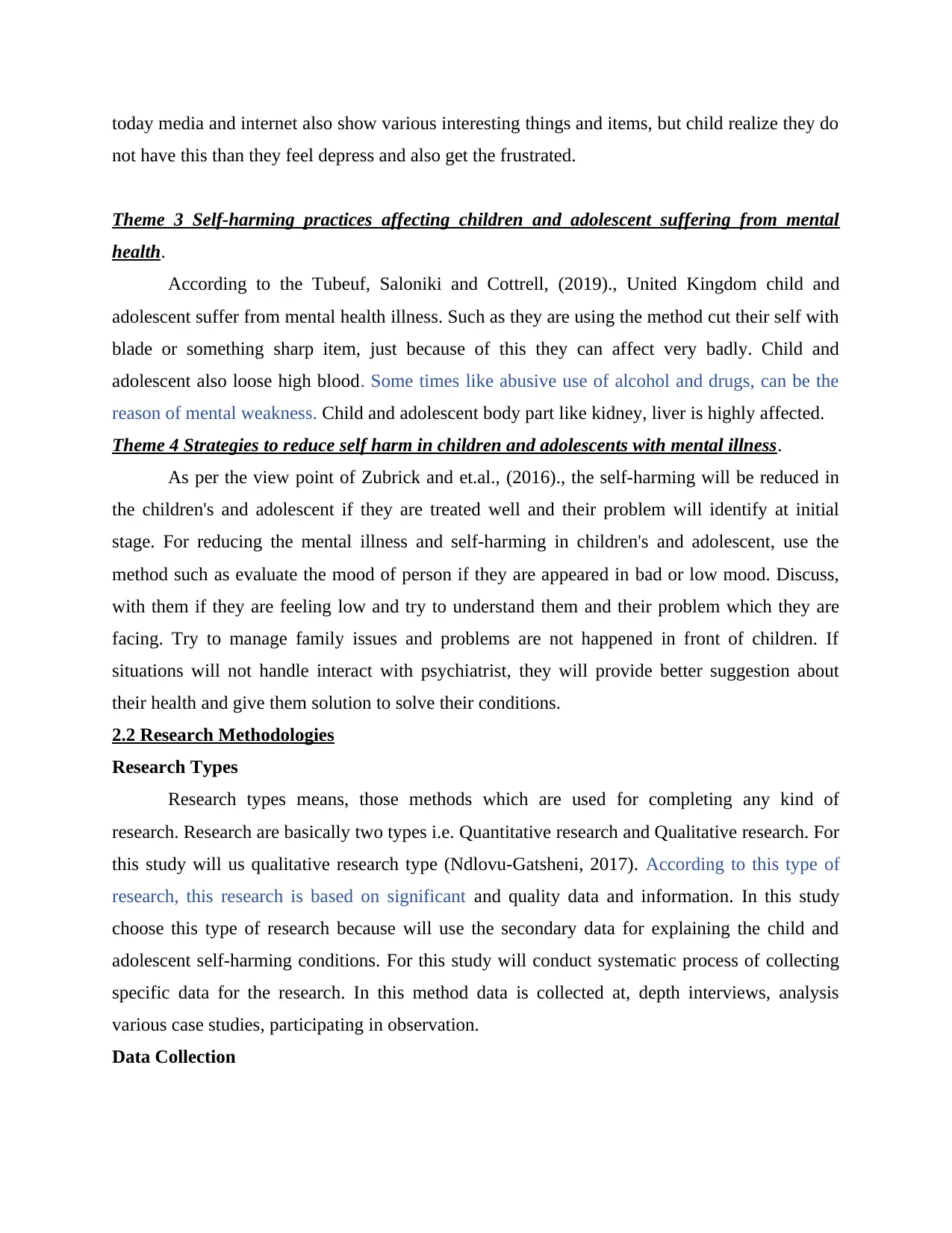
today media and internet also show various interesting things and items, but child realize they do
not have this than they feel depress and also get the frustrated.
Theme 3 Self-harming practices affecting children and adolescent suffering from mental
health.
According to the Tubeuf, Saloniki and Cottrell, (2019)., United Kingdom child and
adolescent suffer from mental health illness. Such as they are using the method cut their self with
blade or something sharp item, just because of this they can affect very badly. Child and
adolescent also loose high blood. Some times like abusive use of alcohol and drugs, can be the
reason of mental weakness. Child and adolescent body part like kidney, liver is highly affected.
Theme 4 Strategies to reduce self harm in children and adolescents with mental illness.
As per the view point of Zubrick and et.al., (2016)., the self-harming will be reduced in
the children's and adolescent if they are treated well and their problem will identify at initial
stage. For reducing the mental illness and self-harming in children's and adolescent, use the
method such as evaluate the mood of person if they are appeared in bad or low mood. Discuss,
with them if they are feeling low and try to understand them and their problem which they are
facing. Try to manage family issues and problems are not happened in front of children. If
situations will not handle interact with psychiatrist, they will provide better suggestion about
their health and give them solution to solve their conditions.
2.2 Research Methodologies
Research Types
Research types means, those methods which are used for completing any kind of
research. Research are basically two types i.e. Quantitative research and Qualitative research. For
this study will us qualitative research type (Ndlovu-Gatsheni, 2017). According to this type of
research, this research is based on significant and quality data and information. In this study
choose this type of research because will use the secondary data for explaining the child and
adolescent self-harming conditions. For this study will conduct systematic process of collecting
specific data for the research. In this method data is collected at, depth interviews, analysis
various case studies, participating in observation.
Data Collection
not have this than they feel depress and also get the frustrated.
Theme 3 Self-harming practices affecting children and adolescent suffering from mental
health.
According to the Tubeuf, Saloniki and Cottrell, (2019)., United Kingdom child and
adolescent suffer from mental health illness. Such as they are using the method cut their self with
blade or something sharp item, just because of this they can affect very badly. Child and
adolescent also loose high blood. Some times like abusive use of alcohol and drugs, can be the
reason of mental weakness. Child and adolescent body part like kidney, liver is highly affected.
Theme 4 Strategies to reduce self harm in children and adolescents with mental illness.
As per the view point of Zubrick and et.al., (2016)., the self-harming will be reduced in
the children's and adolescent if they are treated well and their problem will identify at initial
stage. For reducing the mental illness and self-harming in children's and adolescent, use the
method such as evaluate the mood of person if they are appeared in bad or low mood. Discuss,
with them if they are feeling low and try to understand them and their problem which they are
facing. Try to manage family issues and problems are not happened in front of children. If
situations will not handle interact with psychiatrist, they will provide better suggestion about
their health and give them solution to solve their conditions.
2.2 Research Methodologies
Research Types
Research types means, those methods which are used for completing any kind of
research. Research are basically two types i.e. Quantitative research and Qualitative research. For
this study will us qualitative research type (Ndlovu-Gatsheni, 2017). According to this type of
research, this research is based on significant and quality data and information. In this study
choose this type of research because will use the secondary data for explaining the child and
adolescent self-harming conditions. For this study will conduct systematic process of collecting
specific data for the research. In this method data is collected at, depth interviews, analysis
various case studies, participating in observation.
Data Collection
Paraphrase This Document
Need a fresh take? Get an instant paraphrase of this document with our AI Paraphraser
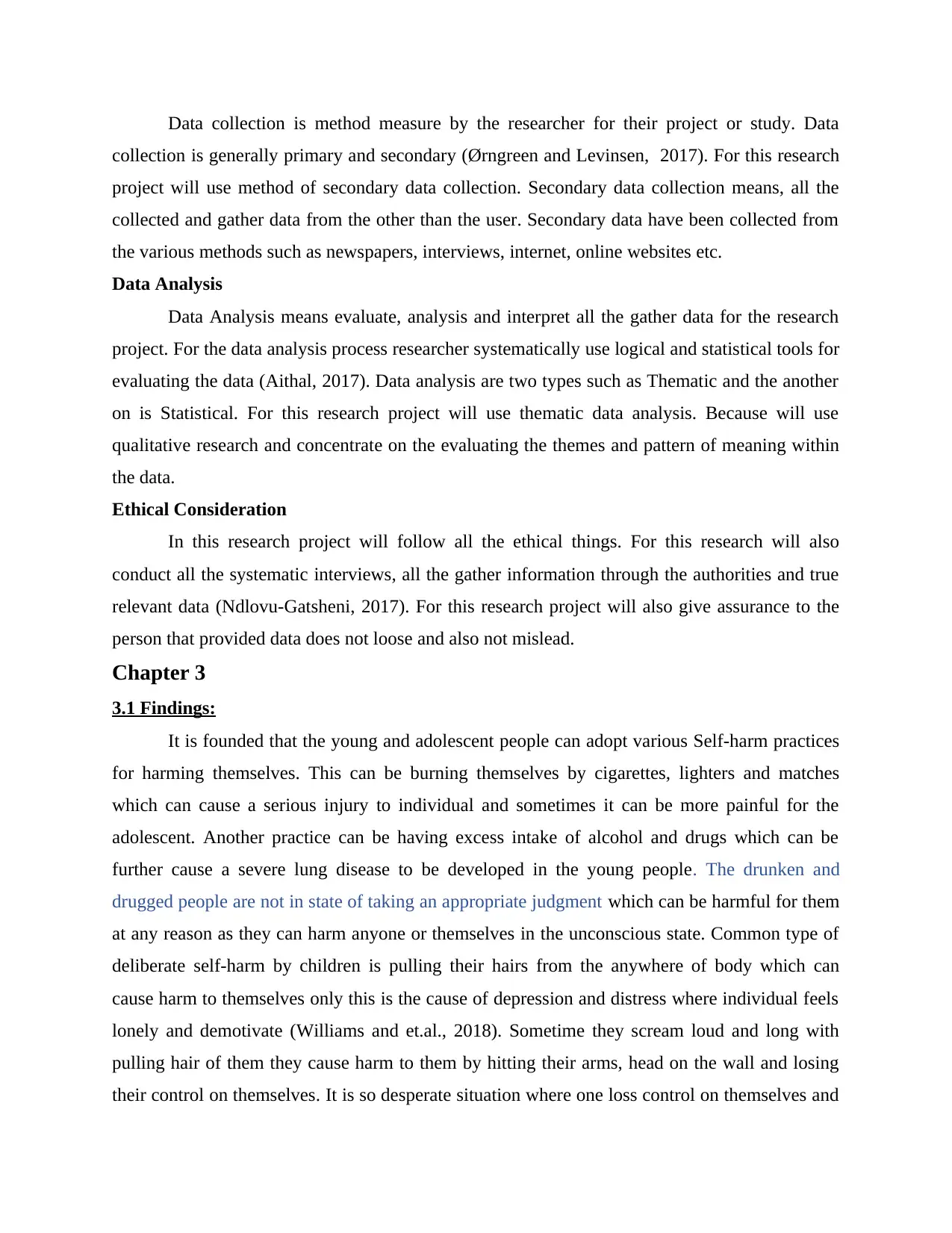
Data collection is method measure by the researcher for their project or study. Data
collection is generally primary and secondary (Ørngreen and Levinsen, 2017). For this research
project will use method of secondary data collection. Secondary data collection means, all the
collected and gather data from the other than the user. Secondary data have been collected from
the various methods such as newspapers, interviews, internet, online websites etc.
Data Analysis
Data Analysis means evaluate, analysis and interpret all the gather data for the research
project. For the data analysis process researcher systematically use logical and statistical tools for
evaluating the data (Aithal, 2017). Data analysis are two types such as Thematic and the another
on is Statistical. For this research project will use thematic data analysis. Because will use
qualitative research and concentrate on the evaluating the themes and pattern of meaning within
the data.
Ethical Consideration
In this research project will follow all the ethical things. For this research will also
conduct all the systematic interviews, all the gather information through the authorities and true
relevant data (Ndlovu-Gatsheni, 2017). For this research project will also give assurance to the
person that provided data does not loose and also not mislead.
Chapter 3
3.1 Findings:
It is founded that the young and adolescent people can adopt various Self-harm practices
for harming themselves. This can be burning themselves by cigarettes, lighters and matches
which can cause a serious injury to individual and sometimes it can be more painful for the
adolescent. Another practice can be having excess intake of alcohol and drugs which can be
further cause a severe lung disease to be developed in the young people. The drunken and
drugged people are not in state of taking an appropriate judgment which can be harmful for them
at any reason as they can harm anyone or themselves in the unconscious state. Common type of
deliberate self-harm by children is pulling their hairs from the anywhere of body which can
cause harm to themselves only this is the cause of depression and distress where individual feels
lonely and demotivate (Williams and et.al., 2018). Sometime they scream loud and long with
pulling hair of them they cause harm to them by hitting their arms, head on the wall and losing
their control on themselves. It is so desperate situation where one loss control on themselves and
collection is generally primary and secondary (Ørngreen and Levinsen, 2017). For this research
project will use method of secondary data collection. Secondary data collection means, all the
collected and gather data from the other than the user. Secondary data have been collected from
the various methods such as newspapers, interviews, internet, online websites etc.
Data Analysis
Data Analysis means evaluate, analysis and interpret all the gather data for the research
project. For the data analysis process researcher systematically use logical and statistical tools for
evaluating the data (Aithal, 2017). Data analysis are two types such as Thematic and the another
on is Statistical. For this research project will use thematic data analysis. Because will use
qualitative research and concentrate on the evaluating the themes and pattern of meaning within
the data.
Ethical Consideration
In this research project will follow all the ethical things. For this research will also
conduct all the systematic interviews, all the gather information through the authorities and true
relevant data (Ndlovu-Gatsheni, 2017). For this research project will also give assurance to the
person that provided data does not loose and also not mislead.
Chapter 3
3.1 Findings:
It is founded that the young and adolescent people can adopt various Self-harm practices
for harming themselves. This can be burning themselves by cigarettes, lighters and matches
which can cause a serious injury to individual and sometimes it can be more painful for the
adolescent. Another practice can be having excess intake of alcohol and drugs which can be
further cause a severe lung disease to be developed in the young people. The drunken and
drugged people are not in state of taking an appropriate judgment which can be harmful for them
at any reason as they can harm anyone or themselves in the unconscious state. Common type of
deliberate self-harm by children is pulling their hairs from the anywhere of body which can
cause harm to themselves only this is the cause of depression and distress where individual feels
lonely and demotivate (Williams and et.al., 2018). Sometime they scream loud and long with
pulling hair of them they cause harm to them by hitting their arms, head on the wall and losing
their control on themselves. It is so desperate situation where one loss control on themselves and
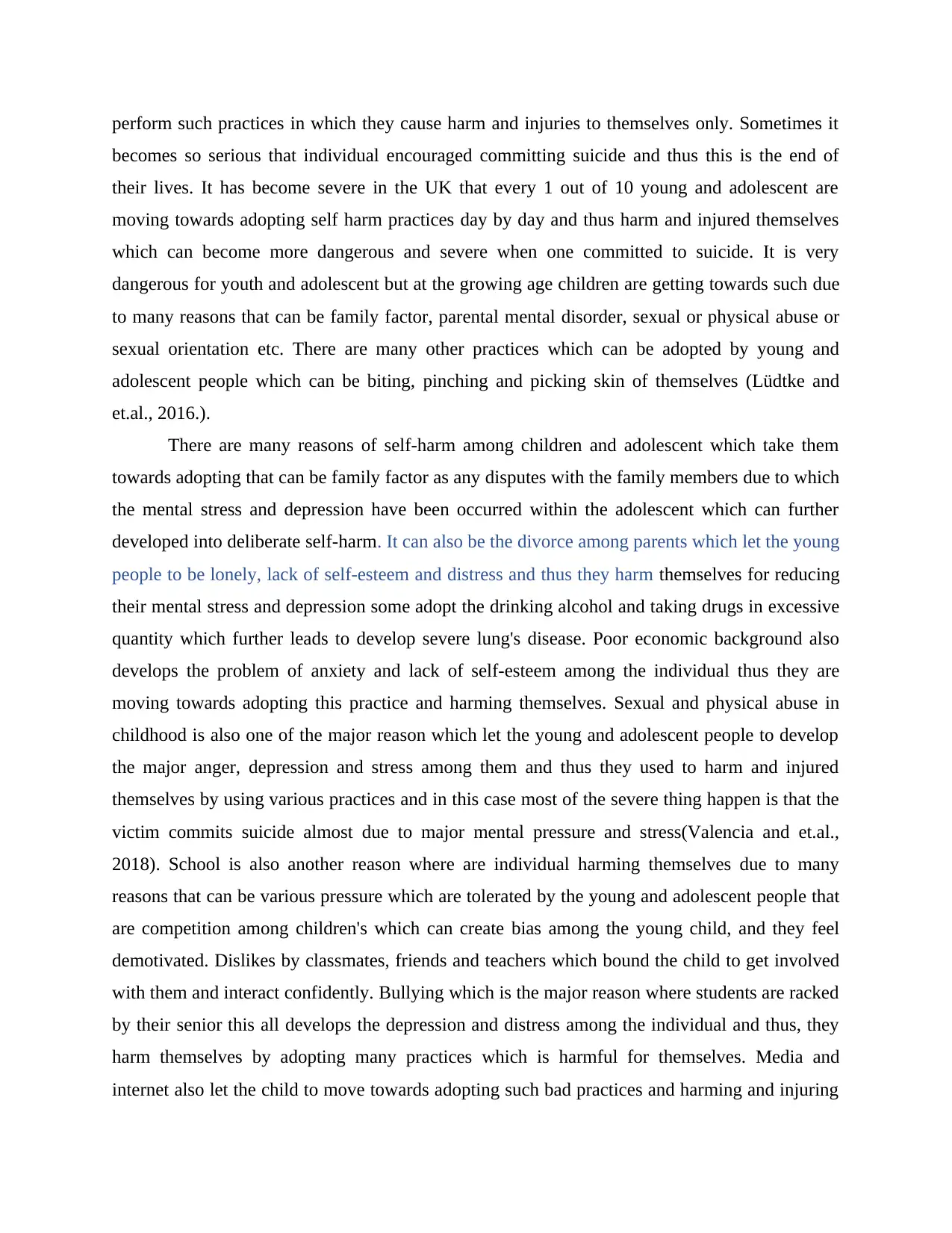
perform such practices in which they cause harm and injuries to themselves only. Sometimes it
becomes so serious that individual encouraged committing suicide and thus this is the end of
their lives. It has become severe in the UK that every 1 out of 10 young and adolescent are
moving towards adopting self harm practices day by day and thus harm and injured themselves
which can become more dangerous and severe when one committed to suicide. It is very
dangerous for youth and adolescent but at the growing age children are getting towards such due
to many reasons that can be family factor, parental mental disorder, sexual or physical abuse or
sexual orientation etc. There are many other practices which can be adopted by young and
adolescent people which can be biting, pinching and picking skin of themselves (Lüdtke and
et.al., 2016.).
There are many reasons of self-harm among children and adolescent which take them
towards adopting that can be family factor as any disputes with the family members due to which
the mental stress and depression have been occurred within the adolescent which can further
developed into deliberate self-harm. It can also be the divorce among parents which let the young
people to be lonely, lack of self-esteem and distress and thus they harm themselves for reducing
their mental stress and depression some adopt the drinking alcohol and taking drugs in excessive
quantity which further leads to develop severe lung's disease. Poor economic background also
develops the problem of anxiety and lack of self-esteem among the individual thus they are
moving towards adopting this practice and harming themselves. Sexual and physical abuse in
childhood is also one of the major reason which let the young and adolescent people to develop
the major anger, depression and stress among them and thus they used to harm and injured
themselves by using various practices and in this case most of the severe thing happen is that the
victim commits suicide almost due to major mental pressure and stress(Valencia and et.al.,
2018). School is also another reason where are individual harming themselves due to many
reasons that can be various pressure which are tolerated by the young and adolescent people that
are competition among children's which can create bias among the young child, and they feel
demotivated. Dislikes by classmates, friends and teachers which bound the child to get involved
with them and interact confidently. Bullying which is the major reason where students are racked
by their senior this all develops the depression and distress among the individual and thus, they
harm themselves by adopting many practices which is harmful for themselves. Media and
internet also let the child to move towards adopting such bad practices and harming and injuring
becomes so serious that individual encouraged committing suicide and thus this is the end of
their lives. It has become severe in the UK that every 1 out of 10 young and adolescent are
moving towards adopting self harm practices day by day and thus harm and injured themselves
which can become more dangerous and severe when one committed to suicide. It is very
dangerous for youth and adolescent but at the growing age children are getting towards such due
to many reasons that can be family factor, parental mental disorder, sexual or physical abuse or
sexual orientation etc. There are many other practices which can be adopted by young and
adolescent people which can be biting, pinching and picking skin of themselves (Lüdtke and
et.al., 2016.).
There are many reasons of self-harm among children and adolescent which take them
towards adopting that can be family factor as any disputes with the family members due to which
the mental stress and depression have been occurred within the adolescent which can further
developed into deliberate self-harm. It can also be the divorce among parents which let the young
people to be lonely, lack of self-esteem and distress and thus they harm themselves for reducing
their mental stress and depression some adopt the drinking alcohol and taking drugs in excessive
quantity which further leads to develop severe lung's disease. Poor economic background also
develops the problem of anxiety and lack of self-esteem among the individual thus they are
moving towards adopting this practice and harming themselves. Sexual and physical abuse in
childhood is also one of the major reason which let the young and adolescent people to develop
the major anger, depression and stress among them and thus they used to harm and injured
themselves by using various practices and in this case most of the severe thing happen is that the
victim commits suicide almost due to major mental pressure and stress(Valencia and et.al.,
2018). School is also another reason where are individual harming themselves due to many
reasons that can be various pressure which are tolerated by the young and adolescent people that
are competition among children's which can create bias among the young child, and they feel
demotivated. Dislikes by classmates, friends and teachers which bound the child to get involved
with them and interact confidently. Bullying which is the major reason where students are racked
by their senior this all develops the depression and distress among the individual and thus, they
harm themselves by adopting many practices which is harmful for themselves. Media and
internet also let the child to move towards adopting such bad practices and harming and injuring
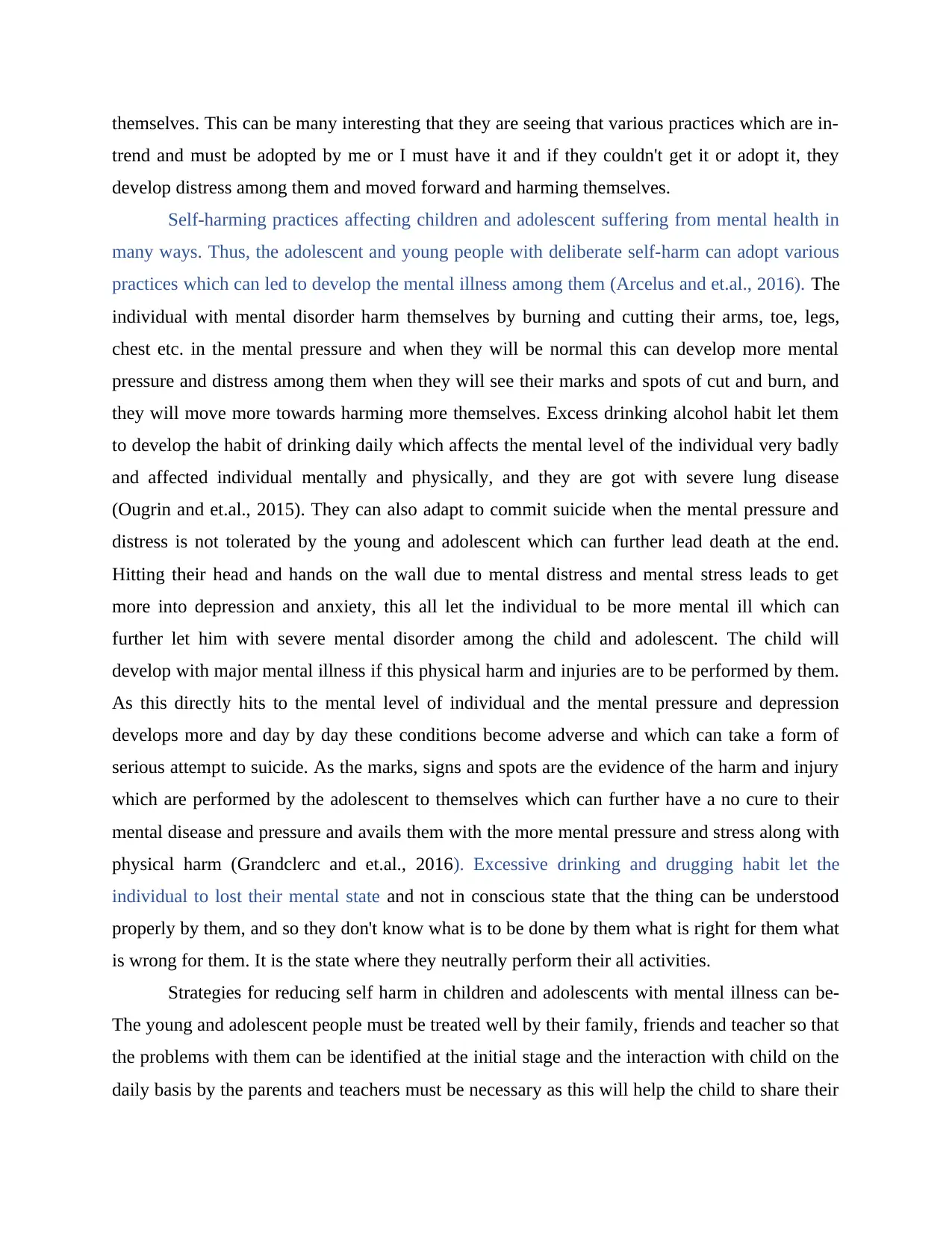
themselves. This can be many interesting that they are seeing that various practices which are in-
trend and must be adopted by me or I must have it and if they couldn't get it or adopt it, they
develop distress among them and moved forward and harming themselves.
Self-harming practices affecting children and adolescent suffering from mental health in
many ways. Thus, the adolescent and young people with deliberate self-harm can adopt various
practices which can led to develop the mental illness among them (Arcelus and et.al., 2016). The
individual with mental disorder harm themselves by burning and cutting their arms, toe, legs,
chest etc. in the mental pressure and when they will be normal this can develop more mental
pressure and distress among them when they will see their marks and spots of cut and burn, and
they will move more towards harming more themselves. Excess drinking alcohol habit let them
to develop the habit of drinking daily which affects the mental level of the individual very badly
and affected individual mentally and physically, and they are got with severe lung disease
(Ougrin and et.al., 2015). They can also adapt to commit suicide when the mental pressure and
distress is not tolerated by the young and adolescent which can further lead death at the end.
Hitting their head and hands on the wall due to mental distress and mental stress leads to get
more into depression and anxiety, this all let the individual to be more mental ill which can
further let him with severe mental disorder among the child and adolescent. The child will
develop with major mental illness if this physical harm and injuries are to be performed by them.
As this directly hits to the mental level of individual and the mental pressure and depression
develops more and day by day these conditions become adverse and which can take a form of
serious attempt to suicide. As the marks, signs and spots are the evidence of the harm and injury
which are performed by the adolescent to themselves which can further have a no cure to their
mental disease and pressure and avails them with the more mental pressure and stress along with
physical harm (Grandclerc and et.al., 2016). Excessive drinking and drugging habit let the
individual to lost their mental state and not in conscious state that the thing can be understood
properly by them, and so they don't know what is to be done by them what is right for them what
is wrong for them. It is the state where they neutrally perform their all activities.
Strategies for reducing self harm in children and adolescents with mental illness can be-
The young and adolescent people must be treated well by their family, friends and teacher so that
the problems with them can be identified at the initial stage and the interaction with child on the
daily basis by the parents and teachers must be necessary as this will help the child to share their
trend and must be adopted by me or I must have it and if they couldn't get it or adopt it, they
develop distress among them and moved forward and harming themselves.
Self-harming practices affecting children and adolescent suffering from mental health in
many ways. Thus, the adolescent and young people with deliberate self-harm can adopt various
practices which can led to develop the mental illness among them (Arcelus and et.al., 2016). The
individual with mental disorder harm themselves by burning and cutting their arms, toe, legs,
chest etc. in the mental pressure and when they will be normal this can develop more mental
pressure and distress among them when they will see their marks and spots of cut and burn, and
they will move more towards harming more themselves. Excess drinking alcohol habit let them
to develop the habit of drinking daily which affects the mental level of the individual very badly
and affected individual mentally and physically, and they are got with severe lung disease
(Ougrin and et.al., 2015). They can also adapt to commit suicide when the mental pressure and
distress is not tolerated by the young and adolescent which can further lead death at the end.
Hitting their head and hands on the wall due to mental distress and mental stress leads to get
more into depression and anxiety, this all let the individual to be more mental ill which can
further let him with severe mental disorder among the child and adolescent. The child will
develop with major mental illness if this physical harm and injuries are to be performed by them.
As this directly hits to the mental level of individual and the mental pressure and depression
develops more and day by day these conditions become adverse and which can take a form of
serious attempt to suicide. As the marks, signs and spots are the evidence of the harm and injury
which are performed by the adolescent to themselves which can further have a no cure to their
mental disease and pressure and avails them with the more mental pressure and stress along with
physical harm (Grandclerc and et.al., 2016). Excessive drinking and drugging habit let the
individual to lost their mental state and not in conscious state that the thing can be understood
properly by them, and so they don't know what is to be done by them what is right for them what
is wrong for them. It is the state where they neutrally perform their all activities.
Strategies for reducing self harm in children and adolescents with mental illness can be-
The young and adolescent people must be treated well by their family, friends and teacher so that
the problems with them can be identified at the initial stage and the interaction with child on the
daily basis by the parents and teachers must be necessary as this will help the child to share their
Secure Best Marks with AI Grader
Need help grading? Try our AI Grader for instant feedback on your assignments.
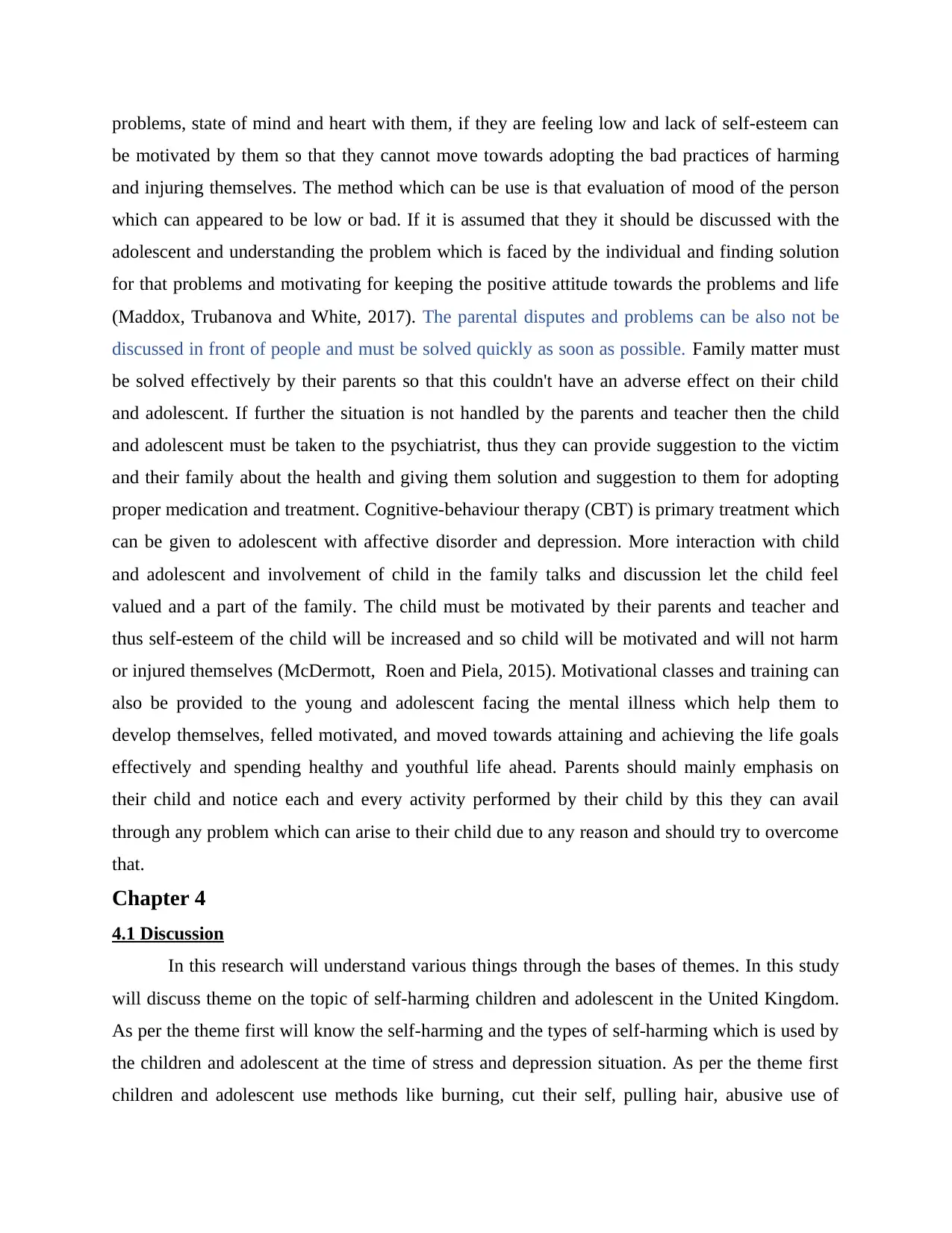
problems, state of mind and heart with them, if they are feeling low and lack of self-esteem can
be motivated by them so that they cannot move towards adopting the bad practices of harming
and injuring themselves. The method which can be use is that evaluation of mood of the person
which can appeared to be low or bad. If it is assumed that they it should be discussed with the
adolescent and understanding the problem which is faced by the individual and finding solution
for that problems and motivating for keeping the positive attitude towards the problems and life
(Maddox, Trubanova and White, 2017). The parental disputes and problems can be also not be
discussed in front of people and must be solved quickly as soon as possible. Family matter must
be solved effectively by their parents so that this couldn't have an adverse effect on their child
and adolescent. If further the situation is not handled by the parents and teacher then the child
and adolescent must be taken to the psychiatrist, thus they can provide suggestion to the victim
and their family about the health and giving them solution and suggestion to them for adopting
proper medication and treatment. Cognitive-behaviour therapy (CBT) is primary treatment which
can be given to adolescent with affective disorder and depression. More interaction with child
and adolescent and involvement of child in the family talks and discussion let the child feel
valued and a part of the family. The child must be motivated by their parents and teacher and
thus self-esteem of the child will be increased and so child will be motivated and will not harm
or injured themselves (McDermott, Roen and Piela, 2015). Motivational classes and training can
also be provided to the young and adolescent facing the mental illness which help them to
develop themselves, felled motivated, and moved towards attaining and achieving the life goals
effectively and spending healthy and youthful life ahead. Parents should mainly emphasis on
their child and notice each and every activity performed by their child by this they can avail
through any problem which can arise to their child due to any reason and should try to overcome
that.
Chapter 4
4.1 Discussion
In this research will understand various things through the bases of themes. In this study
will discuss theme on the topic of self-harming children and adolescent in the United Kingdom.
As per the theme first will know the self-harming and the types of self-harming which is used by
the children and adolescent at the time of stress and depression situation. As per the theme first
children and adolescent use methods like burning, cut their self, pulling hair, abusive use of
be motivated by them so that they cannot move towards adopting the bad practices of harming
and injuring themselves. The method which can be use is that evaluation of mood of the person
which can appeared to be low or bad. If it is assumed that they it should be discussed with the
adolescent and understanding the problem which is faced by the individual and finding solution
for that problems and motivating for keeping the positive attitude towards the problems and life
(Maddox, Trubanova and White, 2017). The parental disputes and problems can be also not be
discussed in front of people and must be solved quickly as soon as possible. Family matter must
be solved effectively by their parents so that this couldn't have an adverse effect on their child
and adolescent. If further the situation is not handled by the parents and teacher then the child
and adolescent must be taken to the psychiatrist, thus they can provide suggestion to the victim
and their family about the health and giving them solution and suggestion to them for adopting
proper medication and treatment. Cognitive-behaviour therapy (CBT) is primary treatment which
can be given to adolescent with affective disorder and depression. More interaction with child
and adolescent and involvement of child in the family talks and discussion let the child feel
valued and a part of the family. The child must be motivated by their parents and teacher and
thus self-esteem of the child will be increased and so child will be motivated and will not harm
or injured themselves (McDermott, Roen and Piela, 2015). Motivational classes and training can
also be provided to the young and adolescent facing the mental illness which help them to
develop themselves, felled motivated, and moved towards attaining and achieving the life goals
effectively and spending healthy and youthful life ahead. Parents should mainly emphasis on
their child and notice each and every activity performed by their child by this they can avail
through any problem which can arise to their child due to any reason and should try to overcome
that.
Chapter 4
4.1 Discussion
In this research will understand various things through the bases of themes. In this study
will discuss theme on the topic of self-harming children and adolescent in the United Kingdom.
As per the theme first will know the self-harming and the types of self-harming which is used by
the children and adolescent at the time of stress and depression situation. As per the theme first
children and adolescent use methods like burning, cut their self, pulling hair, abusive use of
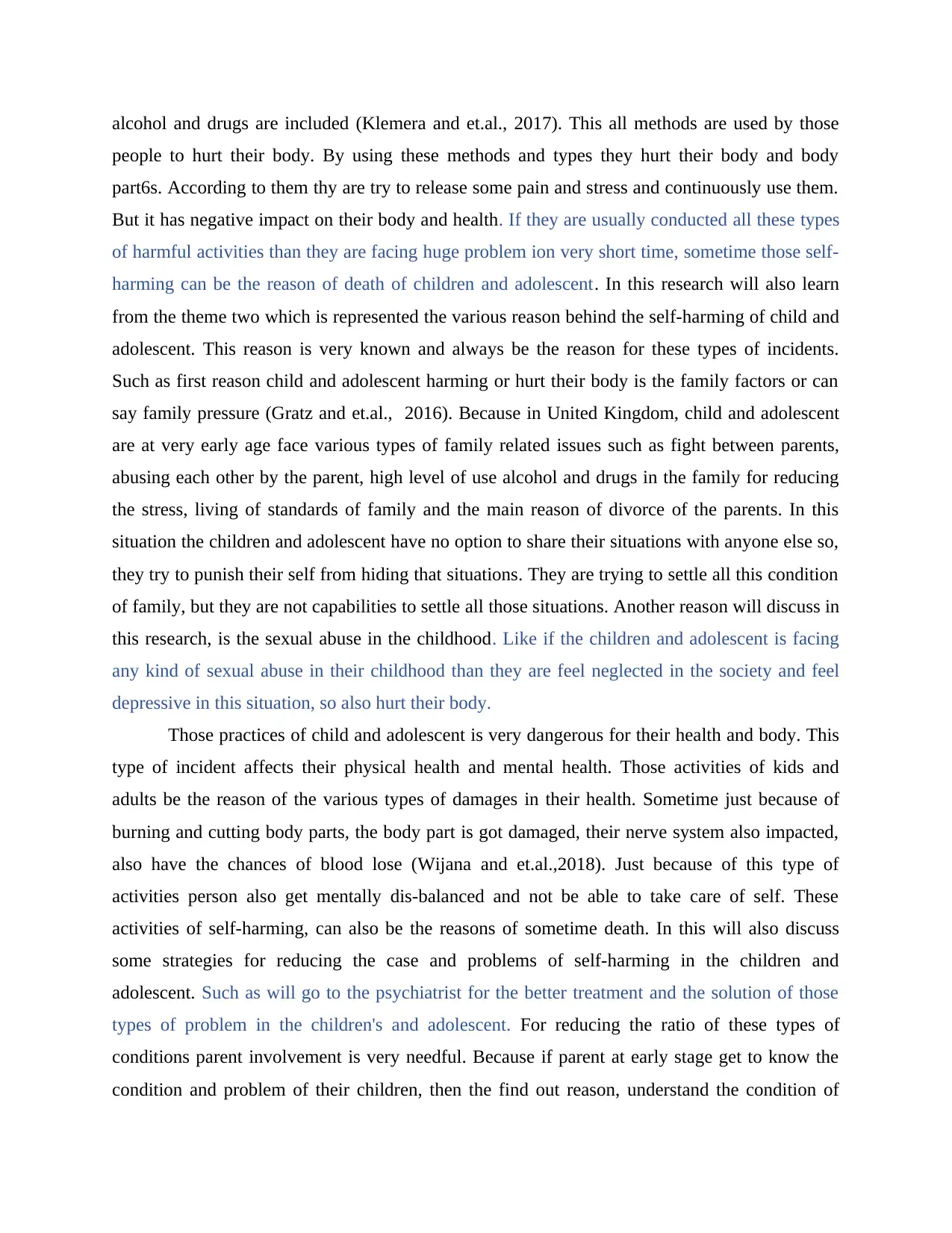
alcohol and drugs are included (Klemera and et.al., 2017). This all methods are used by those
people to hurt their body. By using these methods and types they hurt their body and body
part6s. According to them thy are try to release some pain and stress and continuously use them.
But it has negative impact on their body and health. If they are usually conducted all these types
of harmful activities than they are facing huge problem ion very short time, sometime those self-
harming can be the reason of death of children and adolescent. In this research will also learn
from the theme two which is represented the various reason behind the self-harming of child and
adolescent. This reason is very known and always be the reason for these types of incidents.
Such as first reason child and adolescent harming or hurt their body is the family factors or can
say family pressure (Gratz and et.al., 2016). Because in United Kingdom, child and adolescent
are at very early age face various types of family related issues such as fight between parents,
abusing each other by the parent, high level of use alcohol and drugs in the family for reducing
the stress, living of standards of family and the main reason of divorce of the parents. In this
situation the children and adolescent have no option to share their situations with anyone else so,
they try to punish their self from hiding that situations. They are trying to settle all this condition
of family, but they are not capabilities to settle all those situations. Another reason will discuss in
this research, is the sexual abuse in the childhood. Like if the children and adolescent is facing
any kind of sexual abuse in their childhood than they are feel neglected in the society and feel
depressive in this situation, so also hurt their body.
Those practices of child and adolescent is very dangerous for their health and body. This
type of incident affects their physical health and mental health. Those activities of kids and
adults be the reason of the various types of damages in their health. Sometime just because of
burning and cutting body parts, the body part is got damaged, their nerve system also impacted,
also have the chances of blood lose (Wijana and et.al.,2018). Just because of this type of
activities person also get mentally dis-balanced and not be able to take care of self. These
activities of self-harming, can also be the reasons of sometime death. In this will also discuss
some strategies for reducing the case and problems of self-harming in the children and
adolescent. Such as will go to the psychiatrist for the better treatment and the solution of those
types of problem in the children's and adolescent. For reducing the ratio of these types of
conditions parent involvement is very needful. Because if parent at early stage get to know the
condition and problem of their children, then the find out reason, understand the condition of
people to hurt their body. By using these methods and types they hurt their body and body
part6s. According to them thy are try to release some pain and stress and continuously use them.
But it has negative impact on their body and health. If they are usually conducted all these types
of harmful activities than they are facing huge problem ion very short time, sometime those self-
harming can be the reason of death of children and adolescent. In this research will also learn
from the theme two which is represented the various reason behind the self-harming of child and
adolescent. This reason is very known and always be the reason for these types of incidents.
Such as first reason child and adolescent harming or hurt their body is the family factors or can
say family pressure (Gratz and et.al., 2016). Because in United Kingdom, child and adolescent
are at very early age face various types of family related issues such as fight between parents,
abusing each other by the parent, high level of use alcohol and drugs in the family for reducing
the stress, living of standards of family and the main reason of divorce of the parents. In this
situation the children and adolescent have no option to share their situations with anyone else so,
they try to punish their self from hiding that situations. They are trying to settle all this condition
of family, but they are not capabilities to settle all those situations. Another reason will discuss in
this research, is the sexual abuse in the childhood. Like if the children and adolescent is facing
any kind of sexual abuse in their childhood than they are feel neglected in the society and feel
depressive in this situation, so also hurt their body.
Those practices of child and adolescent is very dangerous for their health and body. This
type of incident affects their physical health and mental health. Those activities of kids and
adults be the reason of the various types of damages in their health. Sometime just because of
burning and cutting body parts, the body part is got damaged, their nerve system also impacted,
also have the chances of blood lose (Wijana and et.al.,2018). Just because of this type of
activities person also get mentally dis-balanced and not be able to take care of self. These
activities of self-harming, can also be the reasons of sometime death. In this will also discuss
some strategies for reducing the case and problems of self-harming in the children and
adolescent. Such as will go to the psychiatrist for the better treatment and the solution of those
types of problem in the children's and adolescent. For reducing the ratio of these types of
conditions parent involvement is very needful. Because if parent at early stage get to know the
condition and problem of their children, then the find out reason, understand the condition of
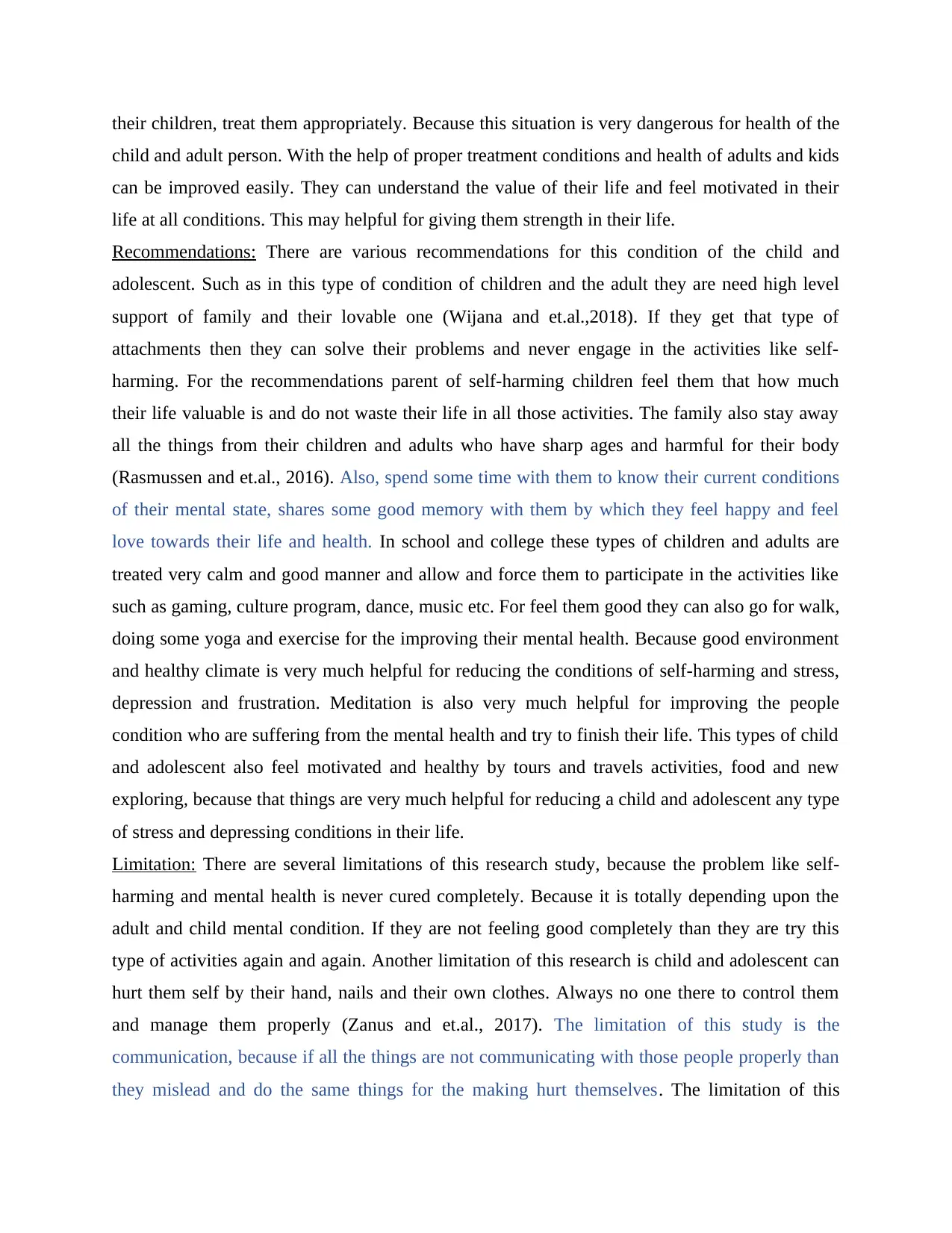
their children, treat them appropriately. Because this situation is very dangerous for health of the
child and adult person. With the help of proper treatment conditions and health of adults and kids
can be improved easily. They can understand the value of their life and feel motivated in their
life at all conditions. This may helpful for giving them strength in their life.
Recommendations: There are various recommendations for this condition of the child and
adolescent. Such as in this type of condition of children and the adult they are need high level
support of family and their lovable one (Wijana and et.al.,2018). If they get that type of
attachments then they can solve their problems and never engage in the activities like self-
harming. For the recommendations parent of self-harming children feel them that how much
their life valuable is and do not waste their life in all those activities. The family also stay away
all the things from their children and adults who have sharp ages and harmful for their body
(Rasmussen and et.al., 2016). Also, spend some time with them to know their current conditions
of their mental state, shares some good memory with them by which they feel happy and feel
love towards their life and health. In school and college these types of children and adults are
treated very calm and good manner and allow and force them to participate in the activities like
such as gaming, culture program, dance, music etc. For feel them good they can also go for walk,
doing some yoga and exercise for the improving their mental health. Because good environment
and healthy climate is very much helpful for reducing the conditions of self-harming and stress,
depression and frustration. Meditation is also very much helpful for improving the people
condition who are suffering from the mental health and try to finish their life. This types of child
and adolescent also feel motivated and healthy by tours and travels activities, food and new
exploring, because that things are very much helpful for reducing a child and adolescent any type
of stress and depressing conditions in their life.
Limitation: There are several limitations of this research study, because the problem like self-
harming and mental health is never cured completely. Because it is totally depending upon the
adult and child mental condition. If they are not feeling good completely than they are try this
type of activities again and again. Another limitation of this research is child and adolescent can
hurt them self by their hand, nails and their own clothes. Always no one there to control them
and manage them properly (Zanus and et.al., 2017). The limitation of this study is the
communication, because if all the things are not communicating with those people properly than
they mislead and do the same things for the making hurt themselves. The limitation of this
child and adult person. With the help of proper treatment conditions and health of adults and kids
can be improved easily. They can understand the value of their life and feel motivated in their
life at all conditions. This may helpful for giving them strength in their life.
Recommendations: There are various recommendations for this condition of the child and
adolescent. Such as in this type of condition of children and the adult they are need high level
support of family and their lovable one (Wijana and et.al.,2018). If they get that type of
attachments then they can solve their problems and never engage in the activities like self-
harming. For the recommendations parent of self-harming children feel them that how much
their life valuable is and do not waste their life in all those activities. The family also stay away
all the things from their children and adults who have sharp ages and harmful for their body
(Rasmussen and et.al., 2016). Also, spend some time with them to know their current conditions
of their mental state, shares some good memory with them by which they feel happy and feel
love towards their life and health. In school and college these types of children and adults are
treated very calm and good manner and allow and force them to participate in the activities like
such as gaming, culture program, dance, music etc. For feel them good they can also go for walk,
doing some yoga and exercise for the improving their mental health. Because good environment
and healthy climate is very much helpful for reducing the conditions of self-harming and stress,
depression and frustration. Meditation is also very much helpful for improving the people
condition who are suffering from the mental health and try to finish their life. This types of child
and adolescent also feel motivated and healthy by tours and travels activities, food and new
exploring, because that things are very much helpful for reducing a child and adolescent any type
of stress and depressing conditions in their life.
Limitation: There are several limitations of this research study, because the problem like self-
harming and mental health is never cured completely. Because it is totally depending upon the
adult and child mental condition. If they are not feeling good completely than they are try this
type of activities again and again. Another limitation of this research is child and adolescent can
hurt them self by their hand, nails and their own clothes. Always no one there to control them
and manage them properly (Zanus and et.al., 2017). The limitation of this study is the
communication, because if all the things are not communicating with those people properly than
they mislead and do the same things for the making hurt themselves. The limitation of this
Paraphrase This Document
Need a fresh take? Get an instant paraphrase of this document with our AI Paraphraser

research study is, that no one always there to take care of the people who are self-harming their
body. This case of self-harming can be happened at the time travel, tours, exercise, home, school,
college or at anywhere. Because this conditions of child and adolescent is completely depending
on upon the mental conditions of them. If they are feeling happy and better than they are never
thought about self-harming but if in their mind they feel depress, low, mood swings than they are
definitely tried to do activities which are harming their body and health.
CONCLUSION
From the bases of above research study, it has been discussed that how child and
adolescent self-harming. In this research study has been included the introduction of the topic
and the background of this research. Also, give the reason that show that how much this topic is
important to conduct research on this. In this research has been also designed aim and objectives
of this research and conduct the research on the bases of objectives. In the part of introduction
has been included, the definition of any complete term and also introduce the main idea of this
research. Complete research has been designed on the base of objectives. In this study has been
included the theme of the research project those themes represented the types, impact, strategies
for the self-harming. With the help of those themes has been designed literature review, which
gives detail about the study and the self-harming. In this research has been included the research
methodologies which has been included the types of research in which has been chosen
qualitative research. In this also included the data collection of the research and also conduct data
analysis for the research. And in the end of research methodology has been included the ethical
consideration. On the bases of above study has been summarized the findings which provided
detail about, that include which can be learned by this research project. And in the end of
research has been disused about complete study that which is understood by the study also
provide some recommendations and the limitation on the self-harming problem of child and
adolescent. That how can this situation can be improved by those suggestions.
body. This case of self-harming can be happened at the time travel, tours, exercise, home, school,
college or at anywhere. Because this conditions of child and adolescent is completely depending
on upon the mental conditions of them. If they are feeling happy and better than they are never
thought about self-harming but if in their mind they feel depress, low, mood swings than they are
definitely tried to do activities which are harming their body and health.
CONCLUSION
From the bases of above research study, it has been discussed that how child and
adolescent self-harming. In this research study has been included the introduction of the topic
and the background of this research. Also, give the reason that show that how much this topic is
important to conduct research on this. In this research has been also designed aim and objectives
of this research and conduct the research on the bases of objectives. In the part of introduction
has been included, the definition of any complete term and also introduce the main idea of this
research. Complete research has been designed on the base of objectives. In this study has been
included the theme of the research project those themes represented the types, impact, strategies
for the self-harming. With the help of those themes has been designed literature review, which
gives detail about the study and the self-harming. In this research has been included the research
methodologies which has been included the types of research in which has been chosen
qualitative research. In this also included the data collection of the research and also conduct data
analysis for the research. And in the end of research methodology has been included the ethical
consideration. On the bases of above study has been summarized the findings which provided
detail about, that include which can be learned by this research project. And in the end of
research has been disused about complete study that which is understood by the study also
provide some recommendations and the limitation on the self-harming problem of child and
adolescent. That how can this situation can be improved by those suggestions.
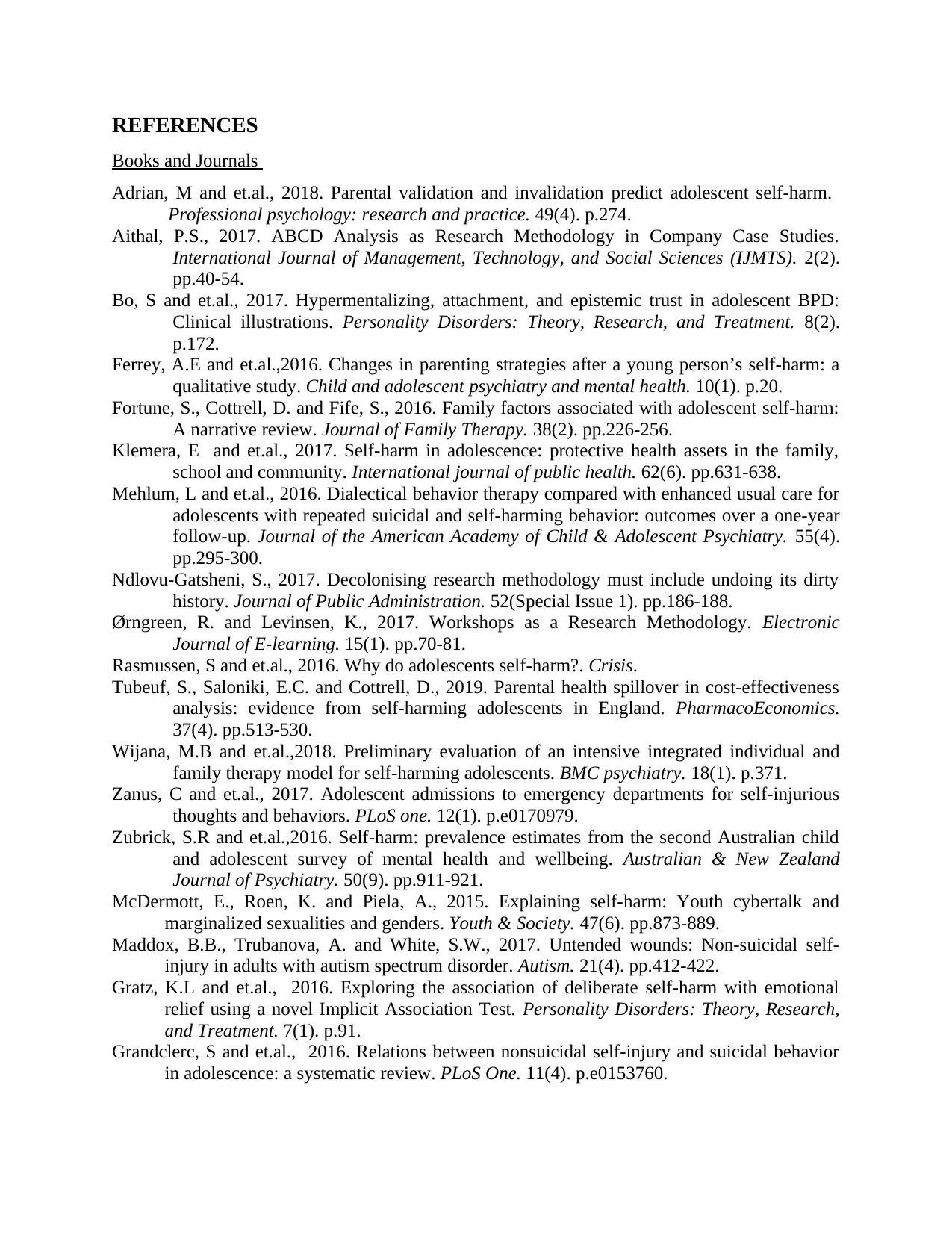
REFERENCES
Books and Journals
Adrian, M and et.al., 2018. Parental validation and invalidation predict adolescent self-harm.
Professional psychology: research and practice. 49(4). p.274.
Aithal, P.S., 2017. ABCD Analysis as Research Methodology in Company Case Studies.
International Journal of Management, Technology, and Social Sciences (IJMTS). 2(2).
pp.40-54.
Bo, S and et.al., 2017. Hypermentalizing, attachment, and epistemic trust in adolescent BPD:
Clinical illustrations. Personality Disorders: Theory, Research, and Treatment. 8(2).
p.172.
Ferrey, A.E and et.al.,2016. Changes in parenting strategies after a young person’s self-harm: a
qualitative study. Child and adolescent psychiatry and mental health. 10(1). p.20.
Fortune, S., Cottrell, D. and Fife, S., 2016. Family factors associated with adolescent self‐harm:
A narrative review. Journal of Family Therapy. 38(2). pp.226-256.
Klemera, E and et.al., 2017. Self-harm in adolescence: protective health assets in the family,
school and community. International journal of public health. 62(6). pp.631-638.
Mehlum, L and et.al., 2016. Dialectical behavior therapy compared with enhanced usual care for
adolescents with repeated suicidal and self-harming behavior: outcomes over a one-year
follow-up. Journal of the American Academy of Child & Adolescent Psychiatry. 55(4).
pp.295-300.
Ndlovu-Gatsheni, S., 2017. Decolonising research methodology must include undoing its dirty
history. Journal of Public Administration. 52(Special Issue 1). pp.186-188.
Ørngreen, R. and Levinsen, K., 2017. Workshops as a Research Methodology. Electronic
Journal of E-learning. 15(1). pp.70-81.
Rasmussen, S and et.al., 2016. Why do adolescents self-harm?. Crisis.
Tubeuf, S., Saloniki, E.C. and Cottrell, D., 2019. Parental health spillover in cost-effectiveness
analysis: evidence from self-harming adolescents in England. PharmacoEconomics.
37(4). pp.513-530.
Wijana, M.B and et.al.,2018. Preliminary evaluation of an intensive integrated individual and
family therapy model for self-harming adolescents. BMC psychiatry. 18(1). p.371.
Zanus, C and et.al., 2017. Adolescent admissions to emergency departments for self-injurious
thoughts and behaviors. PLoS one. 12(1). p.e0170979.
Zubrick, S.R and et.al.,2016. Self-harm: prevalence estimates from the second Australian child
and adolescent survey of mental health and wellbeing. Australian & New Zealand
Journal of Psychiatry. 50(9). pp.911-921.
McDermott, E., Roen, K. and Piela, A., 2015. Explaining self-harm: Youth cybertalk and
marginalized sexualities and genders. Youth & Society. 47(6). pp.873-889.
Maddox, B.B., Trubanova, A. and White, S.W., 2017. Untended wounds: Non-suicidal self-
injury in adults with autism spectrum disorder. Autism. 21(4). pp.412-422.
Gratz, K.L and et.al., 2016. Exploring the association of deliberate self-harm with emotional
relief using a novel Implicit Association Test. Personality Disorders: Theory, Research,
and Treatment. 7(1). p.91.
Grandclerc, S and et.al., 2016. Relations between nonsuicidal self-injury and suicidal behavior
in adolescence: a systematic review. PLoS One. 11(4). p.e0153760.
Books and Journals
Adrian, M and et.al., 2018. Parental validation and invalidation predict adolescent self-harm.
Professional psychology: research and practice. 49(4). p.274.
Aithal, P.S., 2017. ABCD Analysis as Research Methodology in Company Case Studies.
International Journal of Management, Technology, and Social Sciences (IJMTS). 2(2).
pp.40-54.
Bo, S and et.al., 2017. Hypermentalizing, attachment, and epistemic trust in adolescent BPD:
Clinical illustrations. Personality Disorders: Theory, Research, and Treatment. 8(2).
p.172.
Ferrey, A.E and et.al.,2016. Changes in parenting strategies after a young person’s self-harm: a
qualitative study. Child and adolescent psychiatry and mental health. 10(1). p.20.
Fortune, S., Cottrell, D. and Fife, S., 2016. Family factors associated with adolescent self‐harm:
A narrative review. Journal of Family Therapy. 38(2). pp.226-256.
Klemera, E and et.al., 2017. Self-harm in adolescence: protective health assets in the family,
school and community. International journal of public health. 62(6). pp.631-638.
Mehlum, L and et.al., 2016. Dialectical behavior therapy compared with enhanced usual care for
adolescents with repeated suicidal and self-harming behavior: outcomes over a one-year
follow-up. Journal of the American Academy of Child & Adolescent Psychiatry. 55(4).
pp.295-300.
Ndlovu-Gatsheni, S., 2017. Decolonising research methodology must include undoing its dirty
history. Journal of Public Administration. 52(Special Issue 1). pp.186-188.
Ørngreen, R. and Levinsen, K., 2017. Workshops as a Research Methodology. Electronic
Journal of E-learning. 15(1). pp.70-81.
Rasmussen, S and et.al., 2016. Why do adolescents self-harm?. Crisis.
Tubeuf, S., Saloniki, E.C. and Cottrell, D., 2019. Parental health spillover in cost-effectiveness
analysis: evidence from self-harming adolescents in England. PharmacoEconomics.
37(4). pp.513-530.
Wijana, M.B and et.al.,2018. Preliminary evaluation of an intensive integrated individual and
family therapy model for self-harming adolescents. BMC psychiatry. 18(1). p.371.
Zanus, C and et.al., 2017. Adolescent admissions to emergency departments for self-injurious
thoughts and behaviors. PLoS one. 12(1). p.e0170979.
Zubrick, S.R and et.al.,2016. Self-harm: prevalence estimates from the second Australian child
and adolescent survey of mental health and wellbeing. Australian & New Zealand
Journal of Psychiatry. 50(9). pp.911-921.
McDermott, E., Roen, K. and Piela, A., 2015. Explaining self-harm: Youth cybertalk and
marginalized sexualities and genders. Youth & Society. 47(6). pp.873-889.
Maddox, B.B., Trubanova, A. and White, S.W., 2017. Untended wounds: Non-suicidal self-
injury in adults with autism spectrum disorder. Autism. 21(4). pp.412-422.
Gratz, K.L and et.al., 2016. Exploring the association of deliberate self-harm with emotional
relief using a novel Implicit Association Test. Personality Disorders: Theory, Research,
and Treatment. 7(1). p.91.
Grandclerc, S and et.al., 2016. Relations between nonsuicidal self-injury and suicidal behavior
in adolescence: a systematic review. PLoS One. 11(4). p.e0153760.
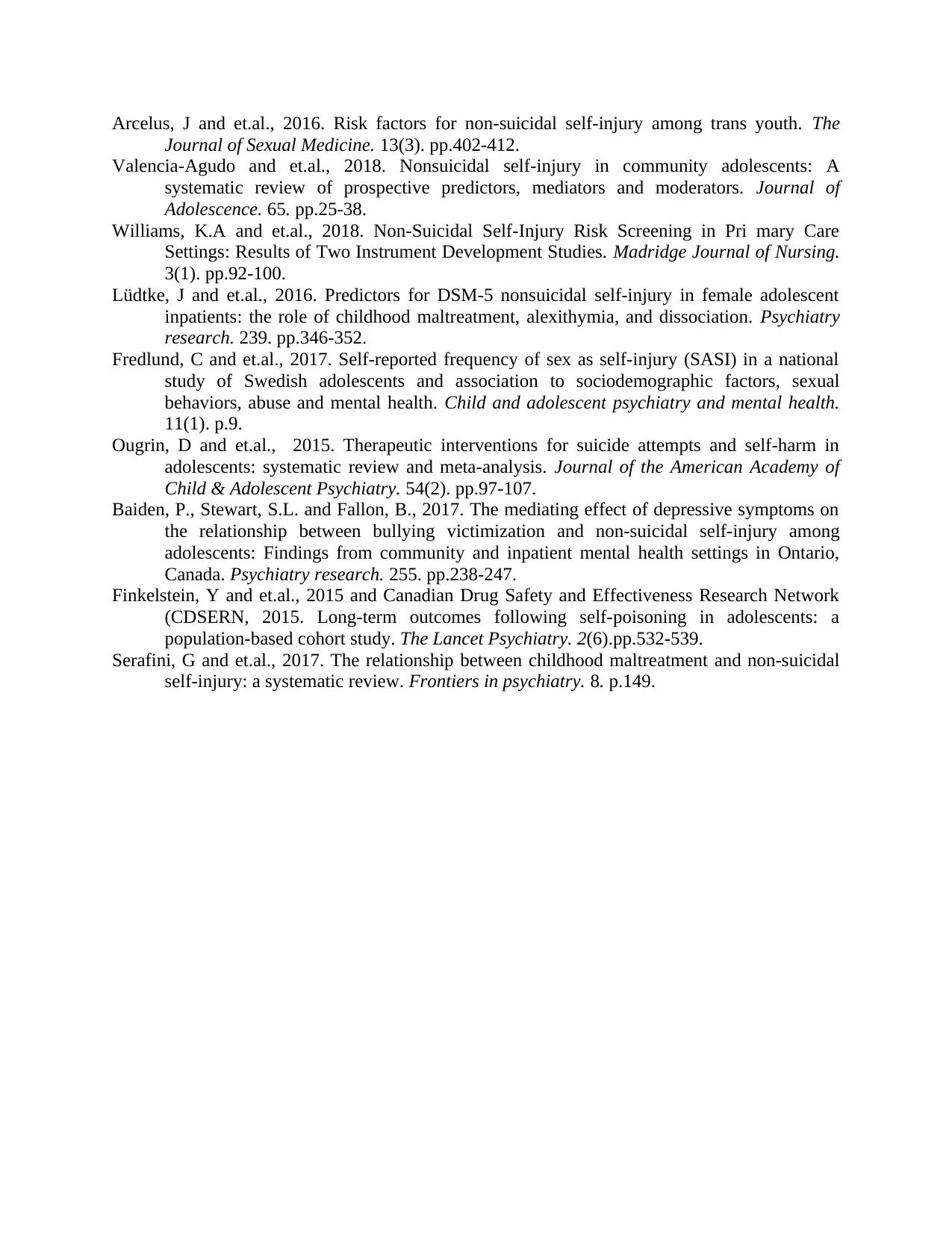
Arcelus, J and et.al., 2016. Risk factors for non-suicidal self-injury among trans youth. The
Journal of Sexual Medicine. 13(3). pp.402-412.
Valencia-Agudo and et.al., 2018. Nonsuicidal self-injury in community adolescents: A
systematic review of prospective predictors, mediators and moderators. Journal of
Adolescence. 65. pp.25-38.
Williams, K.A and et.al., 2018. Non-Suicidal Self-Injury Risk Screening in Pri mary Care
Settings: Results of Two Instrument Development Studies. Madridge Journal of Nursing.
3(1). pp.92-100.
Lüdtke, J and et.al., 2016. Predictors for DSM-5 nonsuicidal self-injury in female adolescent
inpatients: the role of childhood maltreatment, alexithymia, and dissociation. Psychiatry
research. 239. pp.346-352.
Fredlund, C and et.al., 2017. Self-reported frequency of sex as self-injury (SASI) in a national
study of Swedish adolescents and association to sociodemographic factors, sexual
behaviors, abuse and mental health. Child and adolescent psychiatry and mental health.
11(1). p.9.
Ougrin, D and et.al., 2015. Therapeutic interventions for suicide attempts and self-harm in
adolescents: systematic review and meta-analysis. Journal of the American Academy of
Child & Adolescent Psychiatry. 54(2). pp.97-107.
Baiden, P., Stewart, S.L. and Fallon, B., 2017. The mediating effect of depressive symptoms on
the relationship between bullying victimization and non-suicidal self-injury among
adolescents: Findings from community and inpatient mental health settings in Ontario,
Canada. Psychiatry research. 255. pp.238-247.
Finkelstein, Y and et.al., 2015 and Canadian Drug Safety and Effectiveness Research Network
(CDSERN, 2015. Long-term outcomes following self-poisoning in adolescents: a
population-based cohort study. The Lancet Psychiatry. 2(6).pp.532-539.
Serafini, G and et.al., 2017. The relationship between childhood maltreatment and non-suicidal
self-injury: a systematic review. Frontiers in psychiatry. 8. p.149.
Journal of Sexual Medicine. 13(3). pp.402-412.
Valencia-Agudo and et.al., 2018. Nonsuicidal self-injury in community adolescents: A
systematic review of prospective predictors, mediators and moderators. Journal of
Adolescence. 65. pp.25-38.
Williams, K.A and et.al., 2018. Non-Suicidal Self-Injury Risk Screening in Pri mary Care
Settings: Results of Two Instrument Development Studies. Madridge Journal of Nursing.
3(1). pp.92-100.
Lüdtke, J and et.al., 2016. Predictors for DSM-5 nonsuicidal self-injury in female adolescent
inpatients: the role of childhood maltreatment, alexithymia, and dissociation. Psychiatry
research. 239. pp.346-352.
Fredlund, C and et.al., 2017. Self-reported frequency of sex as self-injury (SASI) in a national
study of Swedish adolescents and association to sociodemographic factors, sexual
behaviors, abuse and mental health. Child and adolescent psychiatry and mental health.
11(1). p.9.
Ougrin, D and et.al., 2015. Therapeutic interventions for suicide attempts and self-harm in
adolescents: systematic review and meta-analysis. Journal of the American Academy of
Child & Adolescent Psychiatry. 54(2). pp.97-107.
Baiden, P., Stewart, S.L. and Fallon, B., 2017. The mediating effect of depressive symptoms on
the relationship between bullying victimization and non-suicidal self-injury among
adolescents: Findings from community and inpatient mental health settings in Ontario,
Canada. Psychiatry research. 255. pp.238-247.
Finkelstein, Y and et.al., 2015 and Canadian Drug Safety and Effectiveness Research Network
(CDSERN, 2015. Long-term outcomes following self-poisoning in adolescents: a
population-based cohort study. The Lancet Psychiatry. 2(6).pp.532-539.
Serafini, G and et.al., 2017. The relationship between childhood maltreatment and non-suicidal
self-injury: a systematic review. Frontiers in psychiatry. 8. p.149.
Secure Best Marks with AI Grader
Need help grading? Try our AI Grader for instant feedback on your assignments.

1
1 out of 17
Related Documents
Your All-in-One AI-Powered Toolkit for Academic Success.
+13062052269
info@desklib.com
Available 24*7 on WhatsApp / Email
![[object Object]](/_next/static/media/star-bottom.7253800d.svg)
Unlock your academic potential
© 2024 | Zucol Services PVT LTD | All rights reserved.





